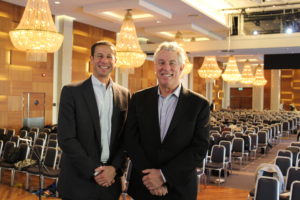
RVTS South in Oslo, Norway interviewed Dr. Bruce Perry and Dr. Stuart Ablon as part of their 2018 Children’s Conference in October 2018. This interview is translated and excerpted from: RVTS Organization; Interview by Siri L. Thorkildsen
 Dr. Bruce Perry of The Child Trauma Academy has worked for years with children who have experienced long-term, complex trauma and gross neglect. Dr. Perry has developed a neuro-sequential model that is based on the stresses the child has experienced. His model helps those impacted by trauma by understanding what brain functions have had been interrupted in development, and seeing their challenges in the context of when in life the trauma occurred.
Dr. Bruce Perry of The Child Trauma Academy has worked for years with children who have experienced long-term, complex trauma and gross neglect. Dr. Perry has developed a neuro-sequential model that is based on the stresses the child has experienced. His model helps those impacted by trauma by understanding what brain functions have had been interrupted in development, and seeing their challenges in the context of when in life the trauma occurred.
Dr. J. Stuart Ablon in Think:Kids at Massachusetts General Hospital has researched how the Collaborative Problem Solving approach helps children – and adults – build good relationships, create security, and develop the brain. With this model the child and you problem-solve, together, through empathetic listening and cooperation. Dr. Perry and Dr. Ablon want to inspire helpers meeting with children who face challenges, and help provide tools and information that are developmentally beneficial for these children.
What is the most important message to those who are meeting with or are parenting children who are facing challenges?
Dr. Perry: “My main message is that you make a big difference. You play a big part, and it is so incredibly important that you are with these children. The most important thing to keep in mind is that, while it is difficult, these meetings will have a meaning and this will make a difference for these children. These meetings provide opportunities for neural pathways to be repaired and new pathways can be created.”
Dr. Stuart Ablon: “Sometimes a meeting is much stronger than you might even understand, even when the meeting lasts only a few seconds. These meetings can have a huge impact on development. Those who are in the main position to help these children are the ones who are most with them. At the same time, these adults are often times the ones who have the least resources, lowest pay, and hardest jobs. When they, in fact, have the most important job.”
Dr. Perry, you have said that love is the most important and strongest change agent. What is the meaning of this when working with children who are having trouble?
“When I talk about “love,” it’s because I want to recognize the emotionally-minded element that is about being able to stand the pressure at its worst. When you can recognize the child for who he or she is although he or she may be very challenging. It is the love that allows you to be present, attentive, thoughtful, and responsive in these healing moments.
One of the things we know is that being associated with someone is one of the most important things to be healed. Ideally, this means that someone shows you love. “Love” means so many things, and it has different meanings in different relationships. But, what I think is important in a healing relationship is that you look at the person in a positive way, no matter what happens. And that you want to be there for them, even if you may not understand them or know what to do. You show that you are there and that you do what you can to help. It’s love that has a real therapeutic effect,” says Perry.
“And it’s really hard to love a child when they behave at their worst. And that’s the biggest challenge, because it’s these kids who need it most. Unfortunately, their behavior makes it difficult because it’s typically viewed as reprehensible. Dr. Perry has helped us understand how this behavior is a result of trauma and this has given people an opportunity to look at these children and the behavior in a whole new light. This also helps change the attitude of the children they meet and meet them on a much more humane and kind level, which makes it possible to actually treat these children with respect – something they rarely experience, but is exactly what they need,” adds Ablon.
When you, Dr. Ablon, say, “Skill, not will,” that “children do as well if they can”: How do we combine that with Dr. Perry’s view of love?
“They are incredibly complementary,” says Ablon.
“Dr. Perry’s research shows that these children do not behave badly because they want to, they actually are doing as well as they can. If they could do well, they would do well. And if they’re struggling, then there is something in the way that makes them unable to do well. What Dr. Perry gives us is an understanding of why it is so, developmentally, while Collaborative Problem Solving provides some practical tools to do something about this,” explains Ablon.
“Yes, they fit like hand in glove because what we try to understand about the child is: Where are they in terms of development?” says Perry.
“Too often we have an expectation for the child based on age. But because of neglect, trauma, or other things that have stood in their way, they are often emotionally, socially and cognitively behind. It is a persistent mismatch that creates conflict, so the moment you can understand where your child is, in terms of development, you can actually meet the child at the right level. And if you use Collaborative Problem Solving, then we can meet the child where he or she is. Then we can create small, glorious doses with challenges that can help them succeed and get them into a good developmental path again. It’s really beautiful when you think of it!” explains Perry.
Why does the world need Collaborative Problem Solving?
“Many parts of the world still misunderstand why children do not behave well or why they do not do what we want them to do. As a result, we are not particularly pleased when it comes to children and youth who challenge us.
What our research shows is that challenging behavior is the result of lagging skills; not because they do not want to behave well. We see this reflected in flexibility, frustration tolerance and problem solving in the child. But this can be learned. And if we build the ability to cope with this, in a loving, understanding environment, we can facilitate development and reduce challenging behavior without having to resort to power and control – something we usually consider as a solution, when we face challenging behavior,” Dr. Ablon answers.
Is it always really so, that children are doing the best they can? Anyone who has experienced bedtime with young children may have other thoughts.
Dr. Ablon laughs, and answers that sometimes the will is not always in place. “But I do not always trust that adults understand the difference between will and skill, especially in the toughest moments when it is most important to understand the difference. Because in those moments we are angry, frustrated, stressed. You are tired yourself, have plenty to do. You may not be in the best mindset to decide if the child does not do what you say because it does not work, or because they simply don’t want to. So then it’s better to take the safest solution, namely to assume that the child is unable to do what you ask for. You do not lose anything by treating a child empathically with the understanding something they are we are asking them to do may be difficult for them. But treating the child as if it does not want to do as you ask, that sends you down a dangerous road. So it is always safest to assume “skill, not will.”
You work has revolutionized the subject and contributed to a paradigm shift, where we fundamentally change how we look at and relate to children who are having a hard time. What do you think of this?
“I think people realize that this change in how we look at behaviorally challenging children makes sense. But change is really difficult. How do we help a child’s brain heal and change? You also have to change the brain of the adult so we can think and behave differently around these children. All these adults are often stuck in a structure, in systems where we have done things in a special way for a long time. It requires a lot of restraint, work – and honestly, discomfort – to change this for us adults too,” Ablon answers.
“We have talked about these concepts for thirty years, but it’s only now that these are ideas are making their way into the professional life without too much resistance and negative reactions. So it takes time,” Perry adds.
“The more I do this work, the more I see that what we must help adults keep calm in difficult situations. Being regulated when the pressure is really on. It’s about the adults, and their ability to stay regulated. If we adults can stay regulated; half the job is done. Most of the time, it’s our own unregulated behavior that creates escalating behavior – and that is when we do not use “common sense” and we do not have access to our own thinking brain.
This is also where an understanding of the brain’s structure is useful. It helps us understand that our feelings and unregulated behavior “infect” others. Learning Collaborative Problem Solving provides concrete strategies that help us to retreat, self-regulate and re-enter the situation in a quieter way,” explains Perry.
Dr. Ablon agrees and emphasizes Dr. Perry’s work in connection to this principle. “Something I’ve always thought you’re doing in a wonderful way, Dr. Perry, is to emphasize that: If it is “contagious” to be unregulated, then the good news is that it is also “contagious” to be regulated. So if adults manage to keep regulated, we will help children regulate themselves too.”